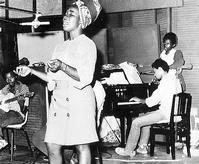Mel Cooke, Freelance Writer
Studio vibes: Rita Marley at mike and members of the Now Generation Band are pictured in the studio of Federal Recording Co. Ltd., 220 Marcus Garvey Drive, doing a recording. - File
Up until late 1984 when a young man named Noel Davy got very excited about a pre-programmed song he had found on a small Casio keyboard, it was actually musicians and not a glorified programmer who created the music for singers and deejays in Jamaican studios.
That rhythm was lost and found, slowed down, recorded and fine-tuned to become the 'Sleng Teng', launched in thunderous fashion by King Jammys Superpower in February 1985. It was not only the announcement of a new era at 60,000 watts of raw power, but naturally the amplified signal of the passing of another.
The era of the studio band.
For while some persons continued to use live musicians, as had been the case since 1951 when Stanley Motta opened Jamaica's first recording studio on Hanover Street in downtown Kingston, for others it became a one-person programming operation.
And there was no need for a producer or studio owner to keep a staff of musicians on hand.
So a tradition of studio bands that went back to the immortal Skatalites, and Tommy McCook and the Supersonics at rival Treasure Isle, the Aggravators for producer Bunny Lee and the Revolutionaries at Channel One, Roots Radics at the Maxfield Avenue studio overlapping the computerised era, died a digital death.
However, with many of the musicians who played in those outfits enjoying elder statesman role in the music industry, meeting with many of the performers they played for at one of the regular vintage concerts, the memories are very much alive.
So when bass player Jackie Jackson, once a member of the Supersonics, encountered John Holt and Ken Boothe at the first CVM TV Startime two Saturdays ago, the tales of times gone and songs that have lasted flew thick and fast.
"We were employed to Treasure Isle and Tommy McCook was the musical director," Jackie Jackson told The Sunday Gleaner. Sunday was the prime day for recording at the Bond Street studio, with the sessions starting at 10:00 a.m. "When you got there the street cork," he recalled. Resident pianist at Treasure Isle, Gladstone Adams, would have reached an hour earlier and sorted out the good, the bad and the 'need some more work'.
Then it was straight into recording for the hopefuls, as well as the standouts on the Treasure Isle roster, those including Alton Ellis, the Paragons, the Melodians, Justin Hinds, the Techniques, Hopeton Lewis and Phyllis Dillon.
Jackson notes that with the same set of musicians doing the recordings in the same studio a particular sound was developed. "When you put on a record you could hear a Coxsone tune and a Duke Reid (Treasure Isle owner) tune and you could hear the difference... Now everything is the same, because everything is mechanical," Jackson said.
At Treasure Isle the musicians were paid by the song and "those days you lick out 10 song, an album, in a day. Every now and then a tune siddung pon yu an' hol yu".
Recording days were long ones, though, as the first session ended at about 2:00 p.m., then there was another run from 4:00 p.m. until 8:00 p.m. and then a restart at 9:00 p.m. for another four-hour stretch.
...Now there is no 'feel and vibes',
Pinkney
Guitarist Dwight Pinkney was a part of a studio band in the early days as well as coming up to the end of the period. First he was with the Sharks, who did three weeks at Studio One from 1965 - 1966, recording three days a week and working with Ken Boothe, Delroy Wilson, the Wailing Wailers and the Gaylads in the process. Then he was with Roots Radics, house band at Channel One, from 1980 into the early 1990s.
It was success on both ends, as in the early batch "all those songs went to number one on the local charts" and, in the later, in 1986 or 1987 out of the to 50 songs for the year over 40 were done by Roots Radics.
Pinkney said Roots Radics worked with from "Jimmy Cliff right through... Marcia Griffiths, Gregory Isaacs, Barrington Levy, Yellowman, Michigan and Smiley, General Trees... Everybody wanted to record with Roots Radics. Our rhythm was the rhythm of the day for the 1980s," Pinkney said.
And that rhythm by a group of musicians is a "totally different thing. The one man thing is very mechanical. There is a thing we call feel and vibes. The musicians in the studio come in like a football team. You can't predict the next move.... When you have talented, versatile musicians in the studio, you have a certain feel".
'Talented' and versatile' are key words, hence the reason why, in these days of virtually no house bands, it seems to be almost the same set of musicians playing on most recordings when sessions are called. "Producers get the proficient people who deliver, don't waste time and have feel," Pinkney said.

